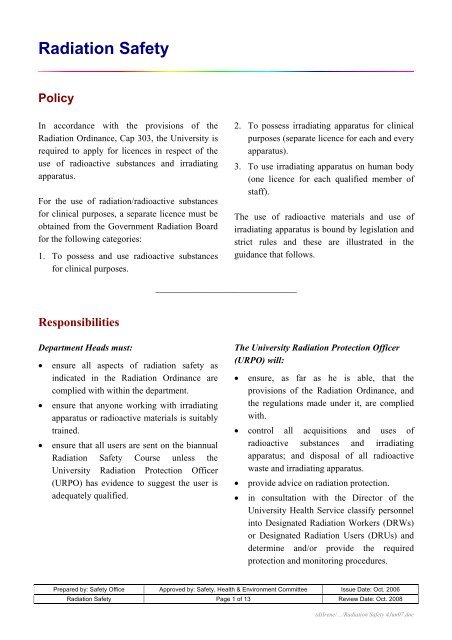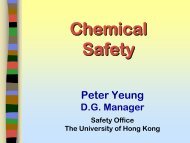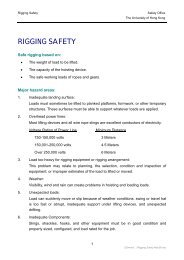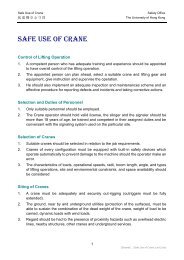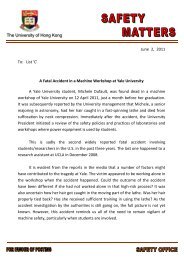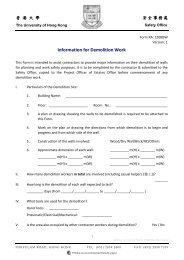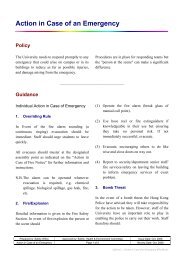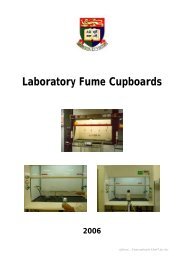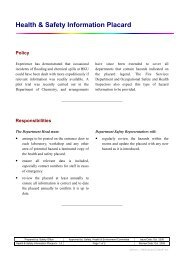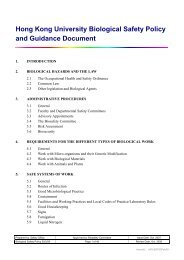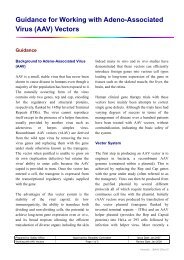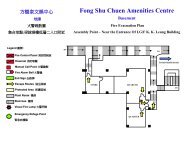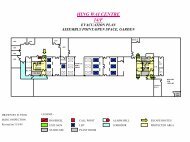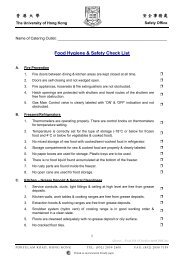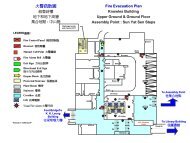Radiation Safety Policy - Safety.hku.hk
Radiation Safety Policy - Safety.hku.hk
Radiation Safety Policy - Safety.hku.hk
You also want an ePaper? Increase the reach of your titles
YUMPU automatically turns print PDFs into web optimized ePapers that Google loves.
<strong>Radiation</strong> <strong>Safety</strong><br />
<strong>Policy</strong><br />
In accordance with the provisions of the<br />
<strong>Radiation</strong> Ordinance, Cap 303, the University is<br />
required to apply for licences in respect of the<br />
use of radioactive substances and irradiating<br />
apparatus.<br />
For the use of radiation/radioactive substances<br />
for clinical purposes, a separate licence must be<br />
obtained from the Government <strong>Radiation</strong> Board<br />
for the following categories:<br />
1. To possess and use radioactive substances<br />
for clinical purposes.<br />
2. To possess irradiating apparatus for clinical<br />
purposes (separate licence for each and every<br />
apparatus).<br />
3. To use irradiating apparatus on human body<br />
(one licence for each qualified member of<br />
staff).<br />
The use of radioactive materials and use of<br />
irradiating apparatus is bound by legislation and<br />
strict rules and these are illustrated in the<br />
guidance that follows.<br />
_______________________________<br />
Responsibilities<br />
Department Heads must:<br />
• ensure all aspects of radiation safety as<br />
indicated in the <strong>Radiation</strong> Ordinance are<br />
complied with within the department.<br />
• ensure that anyone working with irradiating<br />
apparatus or radioactive materials is suitably<br />
trained.<br />
• ensure that all users are sent on the biannual<br />
<strong>Radiation</strong> <strong>Safety</strong> Course unless the<br />
University <strong>Radiation</strong> Protection Officer<br />
(URPO) has evidence to suggest the user is<br />
adequately qualified.<br />
The University <strong>Radiation</strong> Protection Officer<br />
(URPO) will:<br />
• ensure, as far as he is able, that the<br />
provisions of the <strong>Radiation</strong> Ordinance, and<br />
the regulations made under it, are complied<br />
with.<br />
• control all acquisitions and uses of<br />
radioactive substances and irradiating<br />
apparatus; and disposal of all radioactive<br />
waste and irradiating apparatus.<br />
• provide advice on radiation protection.<br />
• in consultation with the Director of the<br />
University Health Service classify personnel<br />
into Designated <strong>Radiation</strong> Workers (DRWs)<br />
or Designated <strong>Radiation</strong> Users (DRUs) and<br />
determine and/or provide the required<br />
protection and monitoring procedures.<br />
Prepared by: <strong>Safety</strong> Office Approved by: <strong>Safety</strong>, Health & Environment Committee Issue Date: Oct. 2006<br />
<strong>Radiation</strong> <strong>Safety</strong> Page 1 of 13 Review Date: Oct. 2008<br />
(d)Irene/…/<strong>Radiation</strong> <strong>Safety</strong> 4Jun07.doc
• supervise, administer, regularly examine and<br />
report as necessary to Council, through the<br />
<strong>Safety</strong>, Health & Environment Committee<br />
(SHEC), on the arrangements made for<br />
protection and personnel monitoring.<br />
• maintain adequate records of the types and<br />
quantities of radioactive substances and<br />
irradiating apparatus held in the University<br />
and of their fates; and the persons exposed to<br />
radiation and the doses of radiation received.<br />
• report through the SHEC to Council for<br />
information, and action where necessary, on<br />
any particularly hazardous operation<br />
proposed, with recommendations for special<br />
precautions.<br />
Departmental <strong>Radiation</strong> <strong>Safety</strong> Representatives<br />
(DRSR) should:<br />
• be responsible for the issue and proper use of<br />
monitoring devices.<br />
• ensure that records are kept of the usage of<br />
radioactive substances.<br />
• supervise the preparation of radioactive<br />
waste for collection.<br />
• provide advice to the Head of Department on<br />
departmental radiation hazards and to liaise<br />
with the URPO.<br />
• arrange annual leak tests for sealed<br />
radioactive sources and functional tests for<br />
radiation monitors as appropriate.<br />
• inform the URPO of any changes of DRWs<br />
or DRUs.<br />
• inform all staff and students within the<br />
Department of departmental radiation<br />
matters.<br />
Designated <strong>Radiation</strong> Workers/Users<br />
(DRWs/DRUs) should:<br />
• comply with all requirements and conditions<br />
associated with designation.<br />
• ensure that radiation exposure to all persons<br />
(including oneself) is kept as low as<br />
reasonably achievable (ALARA principle)<br />
and in any case below the current dose limits<br />
recommended by the International<br />
Commission on Radiological Protection<br />
(ICRP).<br />
• participate in the medical surveillance and<br />
personnel monitoring arrangements. (Failure<br />
to take the necessary examinations on<br />
schedule may lead to suspension of<br />
designation.)<br />
• maintain records of the usage of radioactive<br />
substances.<br />
• report herself immediately to a doctor in the<br />
University Health Service in case of<br />
pregnancy or suspected pregnancy.<br />
• inform the DRSR and/or URPO immediately<br />
of any change in the nature of work.<br />
• inform the DRSR and/or URPO as early as<br />
possible prior to termination of radiation<br />
work or resignation.<br />
• report immediately to the DRSR and/or<br />
URPO any untoward incidents which may<br />
introduce a radiation/contamination hazard.<br />
Staff and students should:<br />
• familiarize themselves with University<br />
radiation safety regulations.<br />
• refrain from unauthorized radiation work<br />
and/or entry to Controlled <strong>Radiation</strong> Areas.<br />
• report all suspected radiation accidents and<br />
any irregularities in radiation protection<br />
services to the departmental or section head.<br />
• suggest improvements for radiation safety to<br />
the URPO.<br />
_______________________________<br />
Prepared by: <strong>Safety</strong> Office Approved by: <strong>Safety</strong>, Health & Environment Committee Issue Date: Oct. 2006<br />
<strong>Radiation</strong> <strong>Safety</strong> Page 2 of 13 Review Date: Oct. 2008<br />
(d)Irene/…/<strong>Radiation</strong> <strong>Safety</strong> 4Jun07.doc
Guidance<br />
1. General Provisions<br />
1.1 Access to Controlled <strong>Radiation</strong> Areas<br />
(CRAs) and Irradiating Apparatus is<br />
strictly prohibited unless permission has<br />
been granted by the URPO or the DRSR in<br />
the case of maintenance service, etc.<br />
1.2 Those who work in approved CRAs or<br />
work with Irradiating Apparatus must<br />
apply for designation via website<br />
http://www.<strong><strong>hk</strong>u</strong>.<strong>hk</strong>/local/radioiso/rpframe.htm.<br />
Additional information is available from<br />
the <strong>Safety</strong> Office, <strong>Radiation</strong> Protection<br />
Unit, Room 318, James Hsioung Lee<br />
Science Building (tel. 28592547/28592546<br />
or e-mail: rpuso@<strong><strong>hk</strong>u</strong>.<strong>hk</strong>).<br />
1.3 The granting of designated status is not<br />
automatic and it may be necessary for<br />
applicants to attend a short training course<br />
and/or take a test on radiation protection.<br />
When designation is granted, it normally<br />
relates to a specific project with an<br />
approved scheme of work to be carried out<br />
in named premises. A personnel radiation<br />
monitoring device will be issued in those<br />
cases where such monitoring is appropriate.<br />
Costs for these devices are chargeable to<br />
departmental budgets.<br />
2. Requisitions for Radioactive<br />
Materials and Irradiating Apparatus<br />
2.1 All orders for radioactive materials and<br />
irradiation apparatus must be approved by<br />
the URPO before dispatch to the supplier.<br />
This approval is normally granted<br />
immediately provided that<br />
• each item is identified for the use of a<br />
designated worker;<br />
• its specification is within the approved<br />
scheme of work; and<br />
• all designation conditions have been met.<br />
Goods received without such prior<br />
approval may not be released to the<br />
department concerned.<br />
2.2 Requisitions may be sent direct to the<br />
<strong>Safety</strong> Office for approval and onward<br />
transmission to the Finance and Enterprises<br />
Office. Overseas goods require an import<br />
licence and removal permit and all<br />
requisitions should be marked "Import<br />
Licence and Removal Permit Required".<br />
2.3 For radioactive goods not consigned to a<br />
local agent, the items will be collected<br />
from the airport by the <strong>Safety</strong> Office staff<br />
using a designated vehicle. Information<br />
concerning such incoming shipments<br />
should be given to the <strong>Safety</strong> Office with<br />
shipment details and expected delivery<br />
date and time as early as possible.<br />
2.4 Gifts or samples of radioactive materials<br />
brought by hand into Hong Kong or posted<br />
directly to a department are subject to<br />
confiscation by the Customs Service.<br />
Should such materials reach University<br />
premises they must be reported<br />
immediately to the URPO for appropriate<br />
action.<br />
Prepared by: <strong>Safety</strong> Office Approved by: <strong>Safety</strong>, Health & Environment Committee Issue Date: Oct. 2006<br />
<strong>Radiation</strong> <strong>Safety</strong> Page 3 of 13 Review Date: Oct. 2008<br />
(d)Irene/…/<strong>Radiation</strong> <strong>Safety</strong> 4Jun07.doc
3. Radioactive Waste Disposal<br />
3.1 All radioactive waste must be collected in<br />
approved and labelled containers under<br />
conditions determined by the URPO. A<br />
waste collection service is available from<br />
the <strong>Safety</strong> Office. It is the responsibility of<br />
the user of radioactive materials to keep<br />
proper records of the nature and content of<br />
the waste material in each container and to<br />
inform the <strong>Safety</strong> Office when collection is<br />
required through our website<br />
http://www.<strong><strong>hk</strong>u</strong>.<strong>hk</strong>/local/radioiso/rpframe.htm<br />
3.2 Radioactive waste MUST NOT be<br />
discharged into sewers or normal rubbish<br />
bins.<br />
3.3 The URPO shall take measures to monitor<br />
waste disposal.<br />
4. Laboratory Monitoring<br />
Each CRA is required to install and operate an<br />
appropriate radiation monitor for the work<br />
performed therein unless exempted by the<br />
URPO. Additionally, air-sampling and surface<br />
monitoring will be carried out by <strong>Safety</strong> Office<br />
staff. In the event of significant contamination<br />
being located, the persons registered for work in<br />
the area are required to undertake the necessary<br />
decontamination procedures and to introduce<br />
precautions to minimize future similar<br />
occurrences.<br />
5. Pregnancy<br />
The radiation dose limits prescribed for DRWs/<br />
DRUs are not applicable during pregnancy,<br />
particularly during the early stages.<br />
DRWs/DRUs who know or suspect that they<br />
have become pregnant, must report immediately<br />
to a doctor in the University Health Service so<br />
that advice may be given and the necessary<br />
action taken.<br />
6. Use of Thermoluminescent<br />
Dosimeters (TLDs)<br />
6.1 The dosimeter should be worn on that part<br />
of the body expected to be exposed to the<br />
highest radiation dose. For certain purposes,<br />
supplementary wrist or finger dosimeters<br />
may be required. For whole body exposure,<br />
the dosimeter may be worn most<br />
conveniently on the coat lapel.<br />
6.2 When not in use for monitoring purposes,<br />
the dosimeter must be stored in a suitable<br />
location away from any source of radiation.<br />
6.3 Under no circumstances should the<br />
dosimeter be opened.<br />
6.4 When taking leave for a period of one<br />
week or more and upon termination of<br />
work, TLD user must deposit their TLD<br />
with their departmental office.<br />
7. Maintenance and Repair Works<br />
Access to CRAs and radiation machines must be<br />
restricted to approved designated personnel. If<br />
technicians, electricians, decorators or labourers.<br />
(e.g. from the Estates Office or Technology<br />
Support Centre) are required to perform a<br />
service function, their access must first be<br />
cleared through DRSR in the department<br />
concerned or the URPO.<br />
Prepared by: <strong>Safety</strong> Office Approved by: <strong>Safety</strong>, Health & Environment Committee Issue Date: Oct. 2006<br />
<strong>Radiation</strong> <strong>Safety</strong> Page 4 of 13 Review Date: Oct. 2008<br />
(d)Irene/…/<strong>Radiation</strong> <strong>Safety</strong> 4Jun07.doc
This procedure is necessary to ensure that the<br />
service staff are adequately warned and<br />
instructed on the possible hazards associated<br />
with the job for which they are being called upon.<br />
8. Receipt of a Shipment of<br />
Radioactive Materials<br />
On receipt of a package of radioactive materials:<br />
8.1 Wear rubber or plastic gloves whilst<br />
processing the package.<br />
8.2 Monitor the outside of the package to<br />
determine the radiation field (hard<br />
betas/gammas) or possible contamination<br />
(soft betas).<br />
8.3 Place the package on a tray in a vented<br />
hood and verify that the contents on the<br />
label agree with original order.<br />
8.4 Install suitable shielding around the<br />
package (hard betas/gammas).<br />
8.5 Open the package and inspect the container<br />
immediately after receipt. Delay may<br />
mean that vendors will not accept damage<br />
claims. Long storage, possibly in an<br />
inverted position, may also cause<br />
difficulties on opening, particularly with<br />
small volumes of high specific activity<br />
material.<br />
8.6 Check for possible breakages or cracks in<br />
the vial. Perform wipe tests as necessary.<br />
8.7 Record nuclide, chemical composition,<br />
activity and date of receipt in register.<br />
Ensure container is properly labeled.<br />
8.8 If material is not to be used immediately,<br />
place in safety container and store in a<br />
shielded safe or refrigerator as appropriate.<br />
8.9 In the event of any untoward event or<br />
contamination problem call the URPO<br />
immediately (Tel. 2859 2547).<br />
9. Radioactive Waste<br />
9.1 Different nuclides and different categories<br />
of waste should be segregated at the time<br />
of disposal by the individual DRW/DRU.<br />
Labelled containers are normally provided<br />
in accordance with individual requirements.<br />
10. Working Rules<br />
Each department is generally required to prepare<br />
its own set of laboratory rules and guidelines<br />
which must be in compliance with this document.<br />
11. Laboratory Practices (to minimize<br />
radiation hazards)<br />
11.1 Initial Design of Experiment<br />
11.1.1 All operations should be planned to limit<br />
the spread or dispersal of radioactive<br />
material. To this end all unnecessary<br />
movement of persons or materials should<br />
be avoided.<br />
11.1.2 Planning should allow adequate time for<br />
the operations required.<br />
Prepared by: <strong>Safety</strong> Office Approved by: <strong>Safety</strong>, Health & Environment Committee Issue Date: Oct. 2006<br />
<strong>Radiation</strong> <strong>Safety</strong> Page 5 of 13 Review Date: Oct. 2008<br />
(d)Irene/…/<strong>Radiation</strong> <strong>Safety</strong> 4Jun07.doc
11.1.3 The use of new techniques should first be<br />
tried out with inactive materials or with<br />
material of low activity before being put<br />
into operation.<br />
11.1.4 Areas in which radioactive work is<br />
carried out should be designated, marked<br />
and monitored. At the boundaries of such<br />
areas, monitoring and control measures<br />
should be set up if so required by the<br />
radiation levels present.<br />
11.1.5 Equipment, glassware, tools and cleaning<br />
equipment for use in any particular active<br />
area should not be used for work in<br />
inactive areas and should be suitably<br />
marked. Special consideration should be<br />
given to avoiding contamination of major<br />
items of equipment which might need to<br />
be transferred for economic reasons.<br />
11.1.6 When a choice between several isotopes<br />
of varying toxicities is possible, one of<br />
relatively low toxicity should be used.<br />
11.1.7 Materials of low specific activity should<br />
be used if possible.<br />
11.1.8 The quantity of radioactive substances<br />
chosen as necessary for a specific<br />
purpose should always be as small as<br />
possible.<br />
11.1.9 The working methods should be studied<br />
and procedures adopted to avoid as far as<br />
possible the dispersal of radioactive<br />
material, in particular through the<br />
formation of aerosols, gases, vapours or<br />
dusts.<br />
11.2 Working Procedures (General)<br />
Laboratory rules must be observed absolutely<br />
and these will normally include an appropriate<br />
selection from the following:<br />
11.2.1 The following should not be permitted in<br />
working places containing unsealed<br />
sources:<br />
• Food or beverages.<br />
• Smoking items or snuff tobacco.<br />
• Handbags.<br />
• Lipsticks and other cosmetics, or items<br />
used to apply them.<br />
• Utensils for eating or drinking.<br />
11.2.2 Hands should be washed thoroughly<br />
before leaving the CRA (special attention<br />
should be given to the nails, in between<br />
fingers and outer edges of the hands).<br />
11.2.3 Monitoring of hands, shoes and street<br />
clothing, if worn at work, may also be<br />
necessary before leaving the CRA.<br />
11.2.4 No sealed or unsealed radioactive<br />
sources should be manipulated with the<br />
hands.<br />
11.2.5 All radioactive sources should be<br />
handled with equipment and facilities<br />
providing protection against external<br />
radiation to compile with the following<br />
limits:<br />
Prepared by: <strong>Safety</strong> Office Approved by: <strong>Safety</strong>, Health & Environment Committee Issue Date: Oct. 2006<br />
<strong>Radiation</strong> <strong>Safety</strong> Page 6 of 13 Review Date: Oct. 2008<br />
(d)Irene/…/<strong>Radiation</strong> <strong>Safety</strong> 4Jun07.doc
• inside controlled areas: less than 0.01<br />
mSv/h<br />
• inside supervised areas: less than 0.003<br />
mSv/h<br />
• in general public areas: less than 0.001<br />
mSv/h<br />
11.2.6 Manipulations should be carried out over<br />
a suitable drip tray, or with some form of<br />
double container which will minimize the<br />
importance of breakages or spills. It is<br />
also useful to cover the working surfaces<br />
with absorbent material to soak up minor<br />
spills. The absorbent material should be<br />
changed when unsuitable for further<br />
work and be treated as radioactive waste.<br />
The handling tools and equipment used<br />
should be placed in nonporous trays with<br />
absorbent disposable paper, which should<br />
be changed frequently. Pipettes, stirring<br />
rods and similar equipment should never<br />
be placed directly on the bench or table.<br />
After use, all vessels and tools should be<br />
set aside for special attention when<br />
cleaning.<br />
11.2.7 No solution should be pipetted by mouth<br />
in any isotope laboratory.<br />
11.2.8 Anyone who has an open skin wound<br />
below the wrist (protected by a bandage<br />
or not) should not work with radioactive<br />
isotopes without medical approval.<br />
11.2.9 The use of containers or glassware with<br />
cutting edges should be avoided.<br />
11.2.10 Glass-blowing by mouth should be<br />
avoided in places where unsealed<br />
radioactive substances are utilized.<br />
11.2.11 Only self-adhesive labels should be used<br />
in CRAs. Labels that must be wetted<br />
should be avoided.<br />
11.2.12 Protective clothing appropriate to the<br />
radioactive contamination risks should be<br />
worn by every person in the CRA, even<br />
if only very small quantities of<br />
radioactive materials are manipulated.<br />
11.2.13 Rubber gloves should be worn when<br />
working with unsealed radioactive<br />
substances. Rubber gloves are provided<br />
to protect against contamination of the<br />
skin and are of no value for protection<br />
from penetrating radiation.<br />
11.2.14 Care should be taken to avoid needless<br />
contamination of objects by handling<br />
them with protective gloves, in particular<br />
light switches, taps and door knobs. The<br />
gloves should be either taken off or a<br />
piece of non-contaminated material<br />
(paper), which should be disposed of<br />
afterwards with the contaminated residue,<br />
should be interposed.<br />
11.2.15 Contaminated gloves should be washed<br />
before taking them off.<br />
11.2.16 A method of putting on and removing<br />
rubber gloves without contaminating the<br />
inside of the gloves should be used. This<br />
procedure is such that the inside of the<br />
glove is not touched by the outside, nor is<br />
any part of the outside allowed to come<br />
in contact with the bare skin. It is<br />
desirable to use gloves whose the inside<br />
and outside are distinguishable.<br />
Prepared by: <strong>Safety</strong> Office Approved by: <strong>Safety</strong>, Health & Environment Committee Issue Date: Oct. 2006<br />
<strong>Radiation</strong> <strong>Safety</strong> Page 7 of 13 Review Date: Oct. 2008<br />
(d)Irene/…/<strong>Radiation</strong> <strong>Safety</strong> 4Jun07.doc
11.2.17 Radioactive contamination of the air of<br />
the working places should be reduced as<br />
much as possible. All operations likely to<br />
produce radioactive contamination of the<br />
air through the production of aerosols (in<br />
particular the heating of radioactive<br />
solutions), smoke or vapours should be<br />
done in an air-tight enclosure kept below<br />
atmospheric pressure (glove box) or in a<br />
fume hood.<br />
11.2.18 Wet operations should be used in<br />
preference to dry ones.<br />
11.2.19 Frequent transfers should be avoided.<br />
11.2.20 Clean up spills immediately to prevent<br />
contamination of the atmosphere through<br />
dusting.<br />
For work with animals one must also<br />
pay attention to:<br />
11.2.21 Excreta and body constituents from<br />
biopsies and autopsies and animal<br />
cadavers should be treated as radioactive<br />
wastes. Possible hazards of spread of<br />
contamination through the decomposition<br />
process should be prevented, e.g. by deep<br />
freezing and the use of disinfectants and<br />
sealed plastic containers.<br />
11.2.22 Special provisions for the collection of<br />
excreta and decontamination of cages<br />
should be made.<br />
11.2.23 The radioactive animals or their cages<br />
should be marked with labels indicating<br />
the nature and amount of radioisotopes<br />
used and the time of administration.<br />
11.2.24 No uncontrolled exchange of animals,<br />
instruments or cages between active and<br />
inactive laboratories should be allowed.<br />
11.2.25 Precautions should be taken to prevent<br />
the possibility of contaminated wounds<br />
in the course of handling the animals and<br />
of contamination from radioactive<br />
aerosols or splashings produced by the<br />
animal's movements or by coughing.<br />
11.2.26 The presence of vermin as potential<br />
vectors of contamination should be<br />
considered.<br />
11.3 Storage<br />
11.3.1 All radioactive sources must be clearly<br />
labelled giving information on activity,<br />
date and chemical form.<br />
11.3.2 The place of storage should be<br />
adequately shielded.<br />
11.3.3 Only authorized personnel should be<br />
allowed to introduce or remove sources<br />
into or from the place of storage, which<br />
should be secure against tampering.<br />
11.3.4 The place of storage should be chosen so<br />
as to minimize risk from fire.<br />
11.3.5 The places where sources are stored<br />
should be inspected regularly and<br />
checked for possible contamination.<br />
11.3.6 When either sealed or unsealed sources<br />
are liable to release a radioactive gas,<br />
their place of storage should be<br />
efficiently vented to the open air by<br />
mechanical means before it is opened.<br />
Prepared by: <strong>Safety</strong> Office Approved by: <strong>Safety</strong>, Health & Environment Committee Issue Date: Oct. 2006<br />
<strong>Radiation</strong> <strong>Safety</strong> Page 8 of 13 Review Date: Oct. 2008<br />
(d)Irene/…/<strong>Radiation</strong> <strong>Safety</strong> 4Jun07.doc
11.3.7 Records should be kept of all stored<br />
radioactive sources.<br />
11.3.8 Bottles containing radioactive liquids<br />
should be placed in vessels large enough<br />
to hold the entire contents of the bottles<br />
in case of breakage.<br />
11.3.9 Special precautions are required when<br />
opening vessels containing radioactive<br />
liquids liable to catch fire, explode or<br />
froth.<br />
11.4 Rubber Glove procedure<br />
The technique employed in the procedure is such<br />
that the inside of the glove is not touched by the<br />
outside, nor is any part of the outside allowed to<br />
come into contact with the bare skin. The<br />
procedure is as follows :<br />
11.4.1 The gloves should be dusted internally<br />
with talcum powder.<br />
11.4.2 The cuff of each glove should be folded<br />
over, outwards, for about 5 cm.<br />
11.4.3 Put one glove on by grasping only the<br />
internal folded-back part with the other<br />
hand.<br />
11.4.4 Put the second glove on by holding it<br />
with the fingers of the gloved hand<br />
tucked in the fold and only touching the<br />
outside of the glove.<br />
11.4.5 Unfold the gloves by manipulating the<br />
fingers inside the fold.<br />
11.4.7 Take off the other glove by manipulating<br />
the fingers of the free hand under the cuff<br />
of the glove and fold it back so that an<br />
internal part is exposed which may be<br />
seized, and the remaining hand freed.<br />
It is a great advantage if the inside and the<br />
outside of the gloves can be readily<br />
distinguished, e.g. by colour or texture.<br />
11.5 Transportation within Establishment<br />
11.5.1 No more radioactive material should be<br />
moved than is required.<br />
11.5.2 Radioactive materials should be<br />
transported in adequately shielded and<br />
closed containers. The containers should<br />
be so constructed as to prevent accidental<br />
release of the source material in case of<br />
upset.<br />
11.5.3 The transport container should be clearly<br />
marked with warning signs, such as:<br />
• Nature of contents<br />
• Physical condition<br />
• Activity in becquerel units (e.g. Bq, kBq,<br />
MBq)<br />
11.5.4 Any loss of radioactive materials during<br />
transport should at once be reported to<br />
the URPO.<br />
11.5.5 Suitably trained workers should be in<br />
charge of all transportation of hazardous<br />
quantities of radioactive material inside<br />
an establishment.<br />
11.4.6 In taking off the gloves, seize the fingers<br />
of one glove by the other gloved hand<br />
and pull free.<br />
Prepared by: <strong>Safety</strong> Office Approved by: <strong>Safety</strong>, Health & Environment Committee Issue Date: Oct. 2006<br />
<strong>Radiation</strong> <strong>Safety</strong> Page 9 of 13 Review Date: Oct. 2008<br />
(d)Irene/…/<strong>Radiation</strong> <strong>Safety</strong> 4Jun07.doc
11.6 Accidents<br />
Any unplanned happening which may introduce<br />
a radiation hazard is considered to be an<br />
ACCIDENT or an EMERGENCY. Such<br />
happenings may arise from a wide variety of<br />
causes ranging from a simple spill of radioactive<br />
material to a natural disaster such as flood or<br />
earthquake.<br />
11.6.1 Priority must be given to human safety<br />
according to need and urgency.<br />
11.6.2 A serious fire hazard must take<br />
precedence over a contamination hazard.<br />
11.6.3 Warn all other persons in the vicinity by<br />
the most appropriate means. Inform the<br />
DRSR or the URPO as soon as possible.<br />
11.6.4 In the case of a spill of radioactive<br />
material, without other complications,<br />
primary consideration must be given to<br />
containment of contamination. The<br />
extent of contamination should be<br />
determined and the area clearly marked.<br />
11.6.5 Persons directly contaminated by a wet<br />
spill should immediately remove clothing<br />
affected and thoroughly wash the hands<br />
and other contaminated areas of the body.<br />
11.6.6 If an inhalation hazard exists, all persons<br />
not involved in carrying out planned<br />
safety procedures should vacate the<br />
contaminated area immediately.<br />
11.6.7 If evacuation of the room is required, it<br />
will generally be desirable to shut off all<br />
mechanical ventilation and to close all<br />
outside openings. However, there may be<br />
local conditions which require<br />
consideration. For example, if the release<br />
occurs in or near a fume hood, it may be<br />
disadvantageous to take any action which<br />
would discontinue ventilation by the<br />
hood.<br />
11.6.8 Except in case of injury or other urgent<br />
need, persons who have vacated the<br />
contaminated area should not leave the<br />
immediate vicinity until they have been<br />
monitored and necessary precautions,<br />
such as the removal of shoes or outer<br />
clothing, have been taken to limit further<br />
spread of radioactivity.<br />
11.6.9 Re-entry into the affected area must be<br />
restricted to properly equipped persons<br />
until the area is declared safe by the<br />
DRSR or the URPO.<br />
11.6.10 All accidents should be fully reported.<br />
This report may have an important<br />
bearing on staff health and legal<br />
responsibilities and may assist the URPO<br />
in making a detailed study with a view to<br />
avoiding similar accidents in the future.<br />
11.6.11 All accidents should be investigated and<br />
appropriate measures should be taken to<br />
prevent repetition of the accident.<br />
11.7 Decontamination Procedures<br />
(Personnel)<br />
11.7.1 Decontamination of the eyes should be<br />
undertaken immediately. Not only the<br />
radioactive isotope is to be considered,<br />
but also the chemical nature of the<br />
contaminant and possible complications<br />
due to foreign bodies and mechanical or<br />
chemical irritants. Additional irritation of<br />
the eyes by decontamination procedures<br />
Prepared by: <strong>Safety</strong> Office Approved by: <strong>Safety</strong>, Health & Environment Committee Issue Date: Oct. 2006<br />
<strong>Radiation</strong> <strong>Safety</strong> Page 10 of 13 Review Date: Oct. 2008<br />
(d)Irene/…/<strong>Radiation</strong> <strong>Safety</strong> 4Jun07.doc
should be avoided. Immediate irrigation<br />
of the eyes with a copious amount of<br />
water or with appropriate medically<br />
approved solutions is recommended.<br />
11.7.2 Care should be taken to avoid as far as<br />
possible the spread of the contamination<br />
to uncontaminated parts of the body and<br />
to avoid internal contamination. If there<br />
is a risk of such a spread, an attempt<br />
should first be made to remove the<br />
contamination locally with absorbent<br />
material, and if necessary, with a proper<br />
masking of the adjacent noncontaminated<br />
areas of the skin. A noncontaminated<br />
open wound should be<br />
protected.<br />
11.7.3 The immediate washing of contaminated<br />
areas with water and soap is the method<br />
of choice for removing loose<br />
contamination, subject to certain<br />
elementary precautions:<br />
• Tepid water should be used.<br />
• Soap should not be abrasive or highly<br />
alkaline.<br />
• The washing can be helped by scrubbing<br />
with a soft brush only in such a way as<br />
not to abrade the skin.<br />
• The skin should be washed for a few<br />
minutes at a time, then dried and<br />
monitored.<br />
• Washing can be repeated if necessary (as<br />
indicated by monitoring) provided that<br />
there is no indication of damage to the<br />
skin.<br />
11.7.4 If this procedure fails, only a mild<br />
detergent approved by the URPO might<br />
be used, although repeated applications<br />
of detergents to the same area of the skin,<br />
hands for instance, might injure the skin<br />
and make it penetrable.<br />
11.7.5 Special attention should be paid to proper<br />
decontamination of creases, folds, hair<br />
and such parts of the hands as finger<br />
nails, inter-finger space and the outer<br />
edges of the hands.<br />
11.7.6 The use of organic solvents or of acid or<br />
alkaline solutions should be avoided.<br />
11.7.7 After each decontamination operation,<br />
the treated place should be dried with a<br />
fresh non-contaminated towel or swab<br />
and monitored. All towels and swabs<br />
used in the decontamination process<br />
should be treated as contaminated<br />
material.<br />
11.7.8 While decontaminating the face, special<br />
care should be taken not to contaminate<br />
the eyes or lips.<br />
11.7.9 Attempts to remove contamination which<br />
resists washing should only be made<br />
under medical supervision.<br />
11.8 Decontamination Procedures<br />
(Equipment and Surfaces)<br />
11.8.1 A decision to decontaminate material<br />
must take into account the continuing<br />
value of the material compared with the<br />
cost of decontamination.<br />
11.8.2 Where the half-life of the contaminating<br />
element is short, it may be desirable to<br />
store tools and glassware for decay of<br />
activity rather than to attempt<br />
decontamination.<br />
Prepared by: <strong>Safety</strong> Office Approved by: <strong>Safety</strong>, Health & Environment Committee Issue Date: Oct. 2006<br />
<strong>Radiation</strong> <strong>Safety</strong> Page 11 of 13 Review Date: Oct. 2008<br />
(d)Irene/…/<strong>Radiation</strong> <strong>Safety</strong> 4Jun07.doc
11.8.3 Decontamination of equipment should<br />
generally be done as soon as possible<br />
after its use. In many cases this will<br />
prevent the contamination from getting<br />
fixed and from being ultimately more<br />
difficult to deal with. It will often be<br />
found that surfaces that have been kept<br />
moist are easier to clean.<br />
11.8.4 The cleaning of contaminated glassware<br />
and tools should be done with great care<br />
by informed persons in a well ventilated<br />
hood set aside in the laboratory for that<br />
purpose, or in special decontamination<br />
areas.<br />
11.8.5 The uptake of radioactive substances by<br />
glassware may be reduced by a<br />
preliminary treatment with the<br />
corresponding inactive chemical.<br />
11.8.6 In some cases immersion in solutions of<br />
the non-radioactive isotope of the<br />
contaminant may be tried, although this<br />
is a slow procedure.<br />
11.8.7 The solutions used for cleaning should<br />
not be returned to the stock bottles<br />
between uses.<br />
11.8.8 Laboratory equipment should be<br />
surveyed for residual contamination<br />
following decontamination procedures. If<br />
the residual contamination indicates that<br />
the level of activity remains greater than<br />
that specified as permissible, the<br />
equipment should not be re-used and<br />
should be regarded as radioactive waste.<br />
11.8.9 Spilt liquid should be absorbed on paper<br />
tissue or "Vermiculite". Always work in<br />
towards the centre of contamination and<br />
take care not to "track" the contamination.<br />
Surfaces should be cleaned by wet<br />
methods where possible (dry methods<br />
may create a dust hazard). Do not use<br />
sluicing methods which may spread<br />
contamination.<br />
11.8.10 Self adhesive tapes or strippable paint<br />
may be used on non-porous surfaces for<br />
removal of loose dry contamination.<br />
11.8.11 Contaminated clothing and linen should<br />
not be released to public laundries<br />
without the approval of the URPO.<br />
11.8.12 If the clothing or linen cannot be<br />
decontaminated to a safe level it should<br />
be regarded as radioactive waste.<br />
Prepared by: <strong>Safety</strong> Office Approved by: <strong>Safety</strong>, Health & Environment Committee Issue Date: Oct. 2006<br />
<strong>Radiation</strong> <strong>Safety</strong> Page 12 of 13 Review Date: Oct. 2008<br />
(d)Irene/…/<strong>Radiation</strong> <strong>Safety</strong> 4Jun07.doc
11.9 Useful Decontamination Agents<br />
Type of surface<br />
or equipment<br />
Walls, floors etc.<br />
Contaminated<br />
clothing<br />
Textiles<br />
Plastics<br />
Paints<br />
Rubber<br />
Metals<br />
Decontamination agent<br />
Suitable detergents or wetting agents<br />
(Simple detergents are not satisfactory<br />
and it is preferable to add a little<br />
E.D.T.A.)<br />
Complexing solutions (Combinations<br />
of citric acid, E.D.T.A., etc.) "Decon"<br />
Treatment<br />
A first method for particularly greasy or<br />
dirty surfaces. Use a 0.5% solution with<br />
swabbing or scrubbing action or in a<br />
washing machine for clothing.<br />
Use in the form of a cream or immerse<br />
articles in tanks for periods up to several<br />
hours. (0.8% solution at elevated<br />
temperatures.)<br />
Linoleum Organic solvents To remove the normal waxed coating<br />
carrying off the contamination.<br />
Machine tools<br />
Glassware<br />
Stainless Steel<br />
Mild steel and<br />
light alloys<br />
Ferrous metals<br />
Painted surface<br />
Solvents (Proprietary grease or<br />
emulsifying solvents)<br />
Nitric acid; ammonium citrate;<br />
chromic acid<br />
Sulphuric acid<br />
Sulphuric acid with inhibitors<br />
Nitric acid /Sodium fluoride<br />
Proprietary rust removers<br />
Paint removers<br />
Solvent strippers<br />
Alkaline strippers<br />
Apply directly to heavily oiled and greasy<br />
surfaces with a cloth or brush.<br />
Emulsifying solvents may be rinsed off<br />
with water.<br />
Use in the normal way.<br />
These dissolve the contaminated surface<br />
taking it into solution.<br />
Use in difficult cases where the paint<br />
itself has to be removed<br />
Prepared by: <strong>Safety</strong> Office Approved by: <strong>Safety</strong>, Health & Environment Committee Issue Date: Oct. 2006<br />
<strong>Radiation</strong> <strong>Safety</strong> Page 13 of 13 Review Date: Oct. 2008<br />
(d)Irene/…/<strong>Radiation</strong> <strong>Safety</strong> 4Jun07.doc


